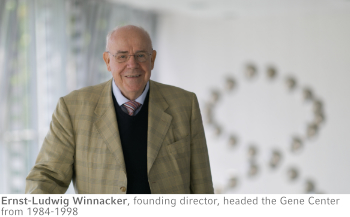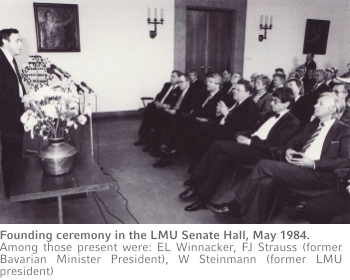Before 1984: Ernst-Ludwig Winnacker - part I
Ernst-Ludwig Winnacker, founding director, remembers the early days of the foundation of the Gene Center
 There were four triggers for the founding of the Gene Center
There were four triggers for the founding of the Gene Center
Firstly, at the end of the 1970s, the German Science Council found the structural conditions of the old chemistry and zoology buildings in Munich's city center at Karl- and Luisenstrasse to be completely unsuitable and unattractive for future developments. The chairman of the Council, Prof. Dieter Simon, a legal scholar from Berlin, described the state of preservation, especially that of the biochemistry part, as a "rat hole". I could only confirm this assessment after my arrival from Cologne at the end of 1976. As it soon turned out, the premises were indeed completely unsuitable for genetic engineering experiments and mammalian cell cultures. Some of the later gene center applications therefore also included an obligation on the part of the applicant, i.e. the Bavarian state government, to provide suitable premises.
The second trigger was the so-called "Hoechst shock"
At the time, Hoechst AG was the largest pharmaceutical company in the world. Then, in 1976, the first work on the isolation of pharmaceutically important mammalian genes, such as the gene for human insulin, was published. Hoechst AG saw this as a threat to its business model, which was traditionally based on the production of insulin and other important hormones, among other things. Since the 1920s, insulin had been purified from the pancreases of cattle and pigs, which were transported worldwide to Frankfurt via cold chains. It was foreseeable that the new production methods from bacterial or yeast cells would significantly simplify access to hormones and growth factors. In 1981, Hoechst AG therefore concluded a 10-year contract with Massachusetts General Hospital in Boston for 70 million dollars in order to gain access to the new technologies. There were a few laboratories in Germany that also used genetic engineering methods. But the critical mass was lacking. This left Hoechst AG with no choice but to go to the USA. Alarmed by this decision, the BMBF therefore developed a competition for the establishment of so-called Gene Centers, which subsequently, between 1982 and 1984, enabled the establishment of interdisciplinary research centers in Heidelberg, Cologne and Munich, and later also in (West) Berlin.
The third trigger was the concern or effort to promote young academics
In terms of early independence, not only existing institutions (chairs) were to be supported through the Gene Center grant, but also temporary junior research groups. There were eight in total at any one time. From 1984 onwards, these were located in vacant premises at the MPI for Biochemistry in Martinsried, and from 1994 onwards in the then completed new Gene Center building in Großhadern, close to the University hospital. Four of the group leaders were selected by the MPG (represented by Prof. Oesterhelt), the other four by myself. To date (2024), around 60 colleagues have completed this training phase, almost all of whom have since taken up independent and permanent positions in Germany and abroad. For me personally they served as models for the establishment of the Emmy-Noether funding scheme during my first term as President of the DFG (1998-2001), and for the Starting Grant scheme of the European Research Council during my tenure as its first Secretary General (2007-2010).
The fourth and final trigger was the requirement for interdisciplinarity
Recombinant DNA technologies turned out to be game changers for all of Biology. It was thus decided from early to offer membership in the Gene Center Grant to colleagues from the faculties of medicine, veterinary medicine, microbiology, biochemistry, pharmacy, botany and zoology. Likewise, candidates for junior research groups were recruited from all of these fields, although at any one time, not all of these fields were represented.
(My own working group initially remained in the old premises on Karlstrasse until it moved into the new building in 1994.This move ended the division of my own workplaces into two parts, mostly in the mornings at the institute in the city center (Karlstrasse) and in the afternoons outside at the MPI for biochemistry with the junior research groups in Martinsried).
 In 1984, the Gene Center was established as a joint enterprise between the LMU Munich and the Max Planck Institutes in Martinsried. It was accommodated in the MPI of Biochemistry in Martinsried until it moved to its current building in Großhadern in 1994. From 1984 onwards, the Gene Center was initially operated as a central facility of the LMU and accordingly managed outside the participating faculties and independently of them. Thus the Gene Center management was responsible directly to the President of the University. Other such central institutions that report directly to the university management were or are, for example, the Institute of Bavarian History or the Munich Center for School Teacher Education.
In 1984, the Gene Center was established as a joint enterprise between the LMU Munich and the Max Planck Institutes in Martinsried. It was accommodated in the MPI of Biochemistry in Martinsried until it moved to its current building in Großhadern in 1994. From 1984 onwards, the Gene Center was initially operated as a central facility of the LMU and accordingly managed outside the participating faculties and independently of them. Thus the Gene Center management was responsible directly to the President of the University. Other such central institutions that report directly to the university management were or are, for example, the Institute of Bavarian History or the Munich Center for School Teacher Education.

